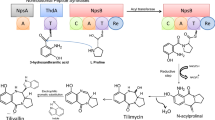Abstract
Reported here are the features of a Rhodotorula mucilaginosa outbreak that occurred in a neonatal intensive care unit. Over a period of 19 days, clinical and laboratory signs of sepsis appeared in four premature infants carrying indwelling vascular catheters. After bloodstream infection with R. mucilaginosa was ascertained, the patients underwent amphotericin B therapy and recovered completely. In a retrospective case-control study, the variables displaying a statistical difference between case and control-group neonates were birth weight, gestational age, duration of parenteral nutrition, duration of antibiotic therapy and prophylactic administration of fluconazole. To our knowledge, this is the first reported outbreak caused by yeasts of the Rhodotorula genus.
Similar content being viewed by others
References
Guarro J, Gené J, Stchigel AM (1999) Developments in fungal taxonomy. Clin Microbiol Rev 12:454–500
Hazen KC (1995) New and emerging yeast pathogens. Clin Microbiol Rev 8:462–478
Hagan ME, Klotz SA, Bartholomew W, Potter L, Nelson M (1995) A pseudoepidemic of Rhodotorula rubra: a marker for the microbial contamination of the bronchoscope. Infect Control Hosp Epidemiol 16:727–728
Kiehn TE, Armstrong D (1990) Changes in the spectrum of organisms causing bacteremia and fungemia in immunocompromised patients due to venous access devices. Eur J Clin Microbiol Infect Dis 9:869–872
Kiehn TE, Gorey E, Brown AE, Edwards FF, Armstrong D (1992) Sepsis due to Rhodotorula related to use of indwelling central venous catheters. Clin Infect Dis 14:841–846
Krcmery V, Krupova I, Denning DW (1999) Invasive yeast infections other than Candida spp. in acute leukaemia. J Hosp Infect 41:181–194
Samonis G, Anatoliotaki M, Apostolakou H, Maraki S, Mavroudis D, Georgoulias V (2001) Transient fungemia due to Rhodotorula rubra in a cancer patient: case report and review of the literature. Infection 29:173–176 DOI: 10.1007/s15010-001-1066-1
Kaufman D, Boyle R, Hazen KC, Patrie JT, Robinson M, Donowitz LG (2001) Fluconazole prophylaxis against fungal colonization and infection in preterm infants. N Engl J Med 345:1660–1666
Louria DB, Greenberg SM, Molander DW (1960) Fungemia caused by certain nonpathogenic strains of the family Cryptococcaceae. Report of two cases due to Rhodotorula and Torulopsis glabrata. N Engl J Med 263:1281–1284
Riopedre RN, De Cesare L, Miatello E, Caría MA, Zapater RC (1960) Aislamiento de Rhodotorula mucilagnosa del L.C.R., heces, orina, exudado faringeo y piel de un lactante de 3 meses. Rev Asoc Med Argent 74:431–434
Shelburne PF, Carey RJ (1962) Rhodotorula fungemia complicating staphylococcal endocarditis. JAMA 180:118–122
Saiman L, Ludington E, Pfaller M, Rangel-Frausto S, Wiblin T, Dawson J, Blumberg HM, Patterson JE, Rinaldi M, Edwards JE, Wenzel RP, Jarvis W, The National Epidemiology of Mycosis Survey Study Group (2000) Risk factors for candidemia in Neonatal Intensive Care Unit patients. Pediatr Infect Dis J 19:319–324
Modi N, Carr R (2000) Promising stratagems for reducing the burden of neonatal sepsis. Arch Dis Child Fetal Neonatal Ed 83:F150–F153 DOI: 10.1136/fn.83.2.F150
Gomez-Lopez A, Mellado E, Rodriguez-Tudela JL, Cuenca-Estrella M (2005) Susceptibility profile of 29 clinical isolates of Rhodotorula spp. and literature review. J Antimicrob Chemother 55:312–316 DOI: 10.1093/jac/dki020
Karlowicz MG, Nickles Hashimoto L, Kelly Jr RE, Buescher ES (2000) Should central venous catheters be removed as soon as candidemia is detected in neonates? Pediatrics 106:e63 DOI: 10.1542/peds.106.5.e63
Author information
Authors and Affiliations
Corresponding author
Rights and permissions
About this article
Cite this article
Perniola, R., Faneschi, M.L., Manso, E. et al. Rhodotorula mucilaginosa outbreak in neonatal intensive care unit: microbiological features, clinical presentation, and analysis of related variables. Eur J Clin Microbiol Infect Dis 25, 193–196 (2006). https://doi.org/10.1007/s10096-006-0114-2
Published:
Issue Date:
DOI: https://doi.org/10.1007/s10096-006-0114-2



